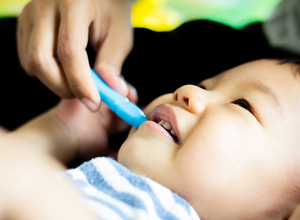
Learn how to take care of the oral health of babies and young children (up to age 6).
What is oral health?
“Oral health” is the health of the teeth, gums, and other parts of the mouth.
Why is it important to take care of my child's oral health?
Your baby’s oral health is an important part of their overall health. And having good oral health early in life sets your child up for good oral health at later stages of life—they will be able to chew better, eat healthy foods, and avoid pain and tooth loss.1 Poor oral health during school age years may also lead to missing more school days and worse academic performance.2
How should I brush my childʼs teeth?
Brushing is one of the main ways that you can keep your childʼs teeth healthy. And having healthy primary teeth (“baby teeth”) helps your child chew food and speak clearly.
Brushing your baby's teeth

For babies and children under 3, use a smear of fluoride toothpaste the size of a grain of rice and brush all sides of their teeth.
- Start to brush your childʼs teeth as soon as their first tooth begins to show. This usually happens at around age six months to 10 months.
- Brush after their first and last meal of the day.
- Use a baby toothbrush with soft bristles and a small head. Use a smear of fluoride toothpaste the size of a grain of rice and brush all sides of your childʼs teeth.
- Be sure that the toothpaste contains fluoride, which helps prevent tooth decay (cavities).
- Using fluoride toothpaste is important no matter where you live; it may be especially important in rural areas, where community water often does not contain fluoride.3
Teaching your child (age 3 to 6) to brush their teeth

For children ages 3 to 6, put a pea-sized amount of toothpaste on the toothbrush.

- Use a child-sized toothbrush with soft bristles and fluoride toothpaste.
- Use a pea-sized amount of toothpaste.
-
Find a position where your child is comfortable and where you can see your childʼs teeth while you brush.
Example
Sit on the floor with your babyʼs or young childʼs head in your lap, or stand behind your child in front of the mirror.

- Gently brush your childʼs teeth using small circles. Brush all sides of the teeth, including the fronts and backs.
- After brushing, have your child spit out the remaining toothpaste but not rinse. The small amount of toothpaste that stays in your childʼs mouth is good for the teeth.
- Young children like to do things by themselves. If your child brushes their own teeth, have an adult watch them to be sure they do it correctly. Dental professionals recommend adult supervision for children under age 7, or for children who canʼt brush their teeth well on their own.
- If youʼre having trouble brushing your childʼs teeth, use a timer, counting game, song, or a video to keep them engaged while brushing. You can also ask the staff at your childʼs dental office or clinic for help.
It’s never too soon! You should start even before your baby’s first tooth comes in.
- When your baby’s first tooth comes in (or no later than their first birthday), take them to the dentist.
- Clean your baby’s gums to remove sugars from liquids or food. Use a clean, damp washcloth to wipe the gums.
- Wiping out your baby’s mouth with a clean wet cloth after nursing or bottle feeding helps ensure good oral hygiene and a strong foundation for your baby’s oral health.
- Clean the pacifier with soap and water.
- Never place a pacifier in your mouth before giving it to your baby. Germs that cause tooth decay can pass from your mouth to your baby’s mouth.
- If the pacifier gets worn out or breaks, get a new one.
- Don’t dip the pacifier in sweet foods like sugar, honey, or syrup.
- Never put a pacifier on a string or ribbon around your baby’s neck. It could choke your baby.
- If your baby is still using a pacifier at 2 years of age, try to ween them from it to reduce possible problems with proper oral development.
When you help your child create habits that encourage good oral health, it can affect their habits for life. You can do this by:
- Brushing your young child’s teeth.
- Providing them with a healthy diet.
- Taking them to the dentist early in life and regularly.
Don’t put your baby to bed with a bottle or sippy cup filled with breast milk, infant formula, fruit juice, or other liquid. These liquids contain sugar, which can cause tooth decay. The sugar in these liquids will stay in the mouth all night and feed the germs that cause cavities.
- Find out if your children qualify and apply for the Children's Health Insurance Program (CHIP). Routine dental visits for your child are free under CHIP. It provides low-cost health coverage to children in families that don’t qualify for Medicaid.
- Find a dentist in your community who sees children and accepts Medicaid and CHIP. States must provide dental benefits to children covered by Medicaid. Benefits include relief of pain and infections, restoring teeth, and maintaining dental health (check-ups).
- Find a health center near your community.
Review handouts from the National Maternal and Child Oral Health Resource Center, Healthy Habits for Happy Smiles.
1. Healthfinder.gov (September 2022). Take Care of Your Child’s Teeth.
2. Centers for Disease Control and Prevention (April 2022). Children’s Oral Health.
3. National Institutes of Health (NIH), National Institute of Dental and Craniofacial Research (NIDCR) (December 2021). Oral Health in America: Advances and Challenges (PDF - 34 MB).